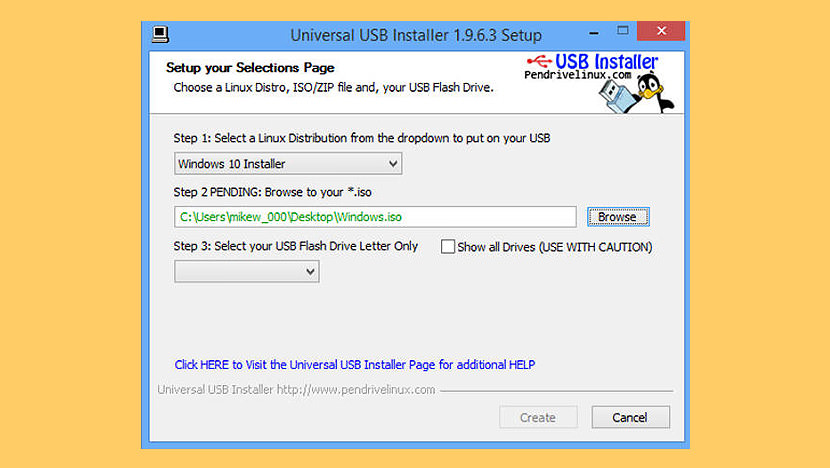

- #How to create windows 10 bootable usb install#
- #How to create windows 10 bootable usb update#
- #How to create windows 10 bootable usb for windows 10#
- #How to create windows 10 bootable usb Pc#
- #How to create windows 10 bootable usb iso#
You can leave the other options at their default values.

For newer computers with UEFI mode enabled, change it to GPT. For older computers with a legacy BIOS mode, change the partition scheme to MBR.
#How to create windows 10 bootable usb iso#
Click the Select button next to the Boot selection field and select your Windows ISO file.Ĭlick the Image option field and change it to Windows to Go. At the Drive Properties window, select your USB drive in the Device field, if it's not already selected. Download, install, and launch the program. Create Drive With RufusĪnother solid utility is Rufus. When the installation process reaches 100%, indicating that it's finished, close the WinToUSB program and remove the USB drive. Click Next and your Windows USB drive will now be created. Click Yes to continue.Īt the next screen, choose the Legacy option for Installation Mode. You can also choose MBR for BIOS and UEFI if you bought one of the paid versions of WinToUSB. For older computers with a legacy BIOS mode, click the MBR for BIOS option.įor newer computers with UEFI mode enabled, click GPT for UEFI. A message will pop up asking you to select a partition scheme. Open the drop-down menu and choose your USB drive. You will then need to select your destination disk. If you're using the free version, your only choice will be Windows 10 Home or Windows 11 Home. Select the version of Windows that you wish to clone onto the USB stick, then click Next.
#How to create windows 10 bootable usb for windows 10#
At the introductory screen, click the search button next to the Image File field and choose the ISO file you created for Windows 10 or 11. Next, connect a blank USB flash drive to your computer and launch WinToUSB from its Start menu shortcut.
#How to create windows 10 bootable usb install#
Download and install the WinToUSB software from its dedicated website. If you need either of these editions, the Professional version of WinToUSB costs $29.95, while the Enterprise option will run you $199.95. You can freely create an installation of the Home version for Windows 10 or Windows 11 but not the Professional or Enterprise flavors. Start with the free version, but be aware that it poses certain limitations. This tool comes in three versions-Free, Professional, and Enterprise. In order to put a bootable ISO file onto your USB drive, it's time to enlist the aid of a third-party program like WinToUSB. Then click the 64-bit Download button and save the ISO file to your hard drive. Choose the product language and click Confirm. Browse to the Download Windows 11 website and scroll down to the Download Windows 11 Disk Image (ISO) section.Ĭlick the Select Download drop-down menu and choose the Windows 11 (multi-edition ISO) option.

In order to run Windows 11 from a USB drive, you’ll need to obtain a Windows 11 ISO file to install the operating system onto the drive. Windows 10 will then generate the necessary ISO file. Though you ultimately want to run Windows from a USB drive, click ISO file (not USB flash drive) and then click Next.Ĭhoose a location on your hard drive to store the Windows ISO file and click Save. You are then asked to choose what media you want to use. Confirm that the language, architecture, and edition are all correct and click Next.
#How to create windows 10 bootable usb Pc#
Then click the Create installation media (USB flash drive, DVD, or ISO file) for another PC button and click Next. At the first screen, click the Access button. Click Download tool now to save a MediaCreationTool.exe file on your PC.ĭouble-click this file to install the program.
#How to create windows 10 bootable usb update#
To do this, navigate to the Download Windows 10 website, which offers the latest edition of Windows 10 as of this writing, that's Windows 10 November 2021 Update or Windows 10 version 21H2. If you want to run Windows 10 from the USB drive, the first step is to sign into your current Windows 10 computer and create a Windows 10 ISO file that will be used to install the operating system onto the drive. Instead, you can turn to two utility programs, WinToUSB and Rufus, which will create a bootable drive from any version of the operating system and on any type of USB drive. However, the company stopped development on that program and no longer updates it. Microsoft once offered its own tool called Windows to Go, which could generate a bootable Windows USB drive with the Enterprise and Education versions of Windows 10. But if you're in a pinch, you can at least work with the OS and access different apps this way. The major downside of booting from a USB drive is that Windows will run slower than it does off your hard drive.


 0 kommentar(er)
0 kommentar(er)
